Services on Demand
Article
Indicators
Related links
-
 Cited by Google
Cited by Google -
 Similars in Google
Similars in Google
Share
Journal of the Southern African Institute of Mining and Metallurgy
On-line version ISSN 2411-9717
Print version ISSN 2225-6253
J. S. Afr. Inst. Min. Metall. vol.112 n.4 Johannesburg Apr. 2012
JOURNAL PAPERS
A trade-off study between down-dip and breast mining on the Merensky Reef at Khomanani 2
S.J.S. Ferreira
Department of Mining Engineering, University of Pretoria
SYNOPSIS
Anglo American Platinum's Khomanani 2 shaft changed over from down-dip mining to breast mining in 2004. The changeover was made to ensure that production targets were met, as it was said that predevelopment for down-dip mining was not fast enough to sustain the required ore reserves; nevertheless, production performance did not increase as expected. In this study a trade-off was performed between down-dip mining and breast mining on the Merensky Reef at Khomanani 2 in order to find the most suitable method for mining the Merensky Reef. Data was gathered by means of a literature survey, underground observations, and interviews with personnel as well as data from various departments on the mine. The two mining methods were studied and then evaluated in terms of the following criteria: safety, mining rate, cost and other factors which were identified as the main drivers of the mine. A scaling system was used to rate the performance of the two mining methods. Analysis of the results shows that down-dip mining and breast mining have the same safety performance ratings. Breast mining has a better mining rate performance than down-dip mining. Breast mining was found to be costly in comparison with down-dip mining, which has a good cost performance rating. The overall ratings of the two mining methods are very similar, with down-dip mining achieving a rating of 76 and breast mining 75.5 out of an optimum 102. Khomanani 2 currently practices breast mining, and with such a slight difference in performance rating between the two methods, it will not be worth changing over to down-dip mining as production is likely to be adversely affected during the changeover. Down-dip mining does, however, have potential for improvement in its performance rating. Further studies focusing on the improvement of the mining rate performance for down-dip mining are needed to see if this potential can be realized. If significant improvement can be made in the performance rating for down-dip mining, a changeover to down-dip mining can be reconsidered.
Keywords: Down-dip mining, breast mining, Merensky Reef, trade-off, comparison.
Introduction
Mine background
The Khomanani 2 Platinum Mine is located 25 km north-east of Rustenburg and forms part of the Rustenburg Section owned by Anglo American Platinum. The narrow tabular orebody being mined forms part of the Western limb of the Bushveld Complex. Two platinum bearing reefs dipping between 9° and 10° are mined, the Merensky Reef and UG2 Reef. Geological disturbances on the mine do not follow a specific pattern and can rather be described as scattered. The current life of mine (LOM) is approximately 13 years on the Merensky Reef, after which the UG2 Reef will extend the LOM further. A conceptual study is underway to extend the LOM by deepening the shaft from 37-41 level; this will extend the LOM by an additional 22 years for the Merensky Reef, after which the UG2 Reef will extend the LOM further.
Project background
During the start up of Khomanani 2, two mining methods were identified as most suitable; namely down-dip mining and breast mining. Both of these methods lend themselves to conventional or mechanized mining, although Khomanani 2 practices conventional mining.
Khomanani 2 started with breast mining, as the predevelopment required was less than for down-dip mining, meaning ore reserves were opened up faster. This is an important factor at the start of a mine. The mine later changed over to down-dip mining, only to change back to breast mining in an attempt to combat various problems that had been identified in previous studies. Although the studies gave rise to identifying the problems, the true causes and correct solutions were not necessarily identified.
A study conducted between 2000 and 2002 established that the predevelopment for down-dip mining is not fast enough to sustain the required ore reserves as the replacement factor is too low and too costly. Initial work indicated that a conversion from down-dip mining to breast mining would reverse this problem and a changeover was made in 2004. Since then production performance has not improved as expectedi.
Figure 1 gives the production targets versus production output on Khomanani 2's Merensky Reef for 2002-2010. The changeover from down-dip mining to breast mining occurred during 2004. Figure 1 does not only indicate that production output has decreased, but also that production targets were not reached after the changeover. It was suggested that the production performance did not improve after the changeover due to changeover problems and other factors such as extra safety procedures that have to be followed nowadays, inaccurate reporting in early years, and geological changes. These factors are taken into account when determining production targets, and therefore should not influence the percentage targets reached. Considering the percentage targets reached instead of the production output alone, there is still a problem. This motivated the re-evaluation of the two mining methods.

This study therefore has re-evaluated the two mining methods, giving particular attention to production capabilities to determine if production targets can be met. This will determine if the drop in production performance is method or non-method related. Non-method related factors have an influence on the production performance, although they will be scoped out of this study, since the aim is to determine whether down-dip mining or breast mining is the most suitable mining method for the Merensky Reef at Khomanani 2 rather than how non-method related factors influence production. This study will focus on the problematic factors/criteria identified in earlier studies, as well as other criteria found to be important.
This project can also be used to indicate whether down-dip mining or breast mining should be used in the new section which is currently undergoing a conceptual study. Changeover factors will not play a major role here.
Problem statement
Down-dip mining and breast mining need to be evaluated individually and then compared by means of a trade-off study in order to find the most suitable method for future mining on the Merensky Reef at Khomanani 2.
Objectives
Conduct a detailed literature survey for background information about the problem, mining methods, and selection methods
Gather information on the two mining methods at Khomanani 2
Evaluate the two mining methods by criteria identified in the project background and literature survey
Perform a trade-off
Draw conclusions from the trade-off results
Make recommendations based on the conclusions.
Methodology
A literature study to gather background information about the mining methods, evaluation criteria, and selection method
Consultation/interviews with mine personnel to gather more information about the mining methods
Underground observations carried out on Merensky Reef sections applying breast mining and on old down-dip mining sections, to gain insight into the application of the two methods
Data collection from various departments in order to gather information about safety, mining rate, cost, and other factors
Calculations, sequencing, and comparisons will be used to evaluate the two mining methods by the criteria identified in the project background and literature survey
A trade-off will be performed by using a scaling system to rate the two mining methods
Conclusions will be derived from a trade-off of the evaluated results
Recommendations will be made based on the conclusions.
Literature survey
Factors to consider for evaluation
The criteria identified for evaluating the two mining methods are listed in this section. A standard block of ground, which is the smallest repeatable unit into which a level can be subdivided, will be used for the evaluation. A standard block of ground has a backlength of 180 m and width of 210 m. Only criteria relevant to evaluating the two mining methods in the already established environment will be considered. The criteria were selected in order to evaluate the two mining methods in terms of the main drivers of the mine and problems identified on the mine. These are discussed under the headings of safety, mining rate, cost, and other. The specific reason why each criterion is important is also given. The following factors can be assumed identical for the two methods: stoping width, extraction ratio, recovery, efficiency, availability, stope turnaround time, and rock men, and material handling capabilities.
Criteria for evaluation
Safety
 Water control - can cause a mud-rush if substandard
Water control - can cause a mud-rush if substandard
 Haulage stability - can cause failure of the haulage
Haulage stability - can cause failure of the haulage
 Pillar stability - can cause a fall of ground (FOG).
Pillar stability - can cause a fall of ground (FOG).
Mining rate
 Development:
Development:
- Amount of predevelopment - determines how fast ore reserves are made available for stoping
- Total development - determines the total time of development and influences the cost.
 Production:
Production:
- Capability in terms of square meters per crew per month - determines the production output.
 Development and production:
Development and production:
- Sequencing - determines the sustainability of the mining rate.
Cost
 Development:
Development:
- On-reef, off-reef development ratio - impacts on the profitability
- Development cost - impacts on the profitability.
 Production:
Production:
- Production cost - impacts on the profitability
 Development and production:
Development and production:
- Overall cost in rand per square meters mined - impacts on the profitability.
Other
Practicality of ventilation requirements - can make maintenance difficult
In-stope support layout practicality - can make implementation difficult
Pre-knowledge of geology - allows preplanning to be done properly
Flexibility - impacts overall performance
Dilution on raises - influences grade control and safety (danger of mining through potholes) 2-6.
Means for selecting a mining method
After the two mining methods had been evaluated in terms of the criteria above, they were allocated a score by using the scale given in Table I. Different criteria carry different weights; these weights were determined by considering the impact of the criteria on the performance and main problems experienced on the mine. Table II gives the allocation of weights. The score was multiplied by its weight and these values were added to give an overall performance rating. The mining method with the higher score will be the better performing one and the more suitable?.
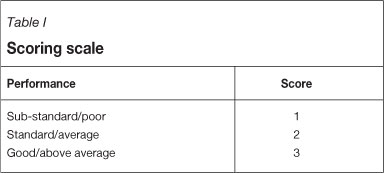
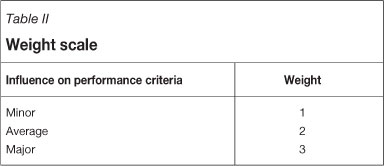
Table III gives the respective weights of the criteria. Note that safety carries a weight of only 2; although it is of utmost importance, the safety criteria considered do not have a major influence on the overall safety performance of the mine, or do not pose a major problem on the mine.
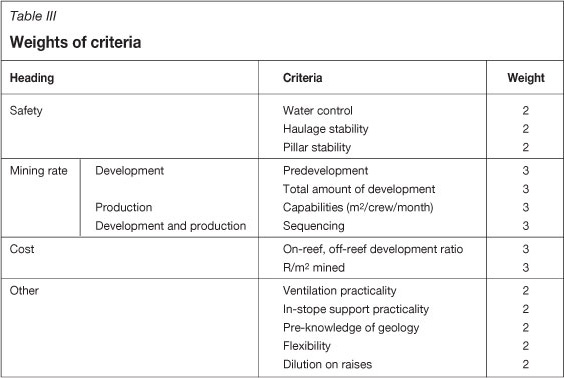
Results
Layout comparison
Figure 2 gives the layouts for down-dip mining and breast mining, which were used in order to determine the way in which the layouts influence the evaluation criteria.
Safety
Water accumulation in the orepasses is more problematic for down-dip mining than for breast mining because all six orepasses are located at the bottom of the raises. This allows water from the face to run off directly into the orepasses. The three orepasses and one y-leg for breast mining are also located in the raise, but only one ore pass is at the bottom. Water first has to run down the advance strike gully (ASG) before it will enter a raise and run down into the orepasses
The haulages for down-dip mining used to be carried too close to the reef horizon being mined, creating stability problems for the haulages. The haulages were moved deeper into the footwall when the changeover to breast mining was made
Due to certain rock engineering design criteria in-stope, crush pillars left on dip provide better support than in stope crush pillars left on strike. The dip of the reef is only 9°, making the difference in support offered by pillars on dip and strike small. This means the in-stope crush pillars left on dip for down-dip mining offer better support than the in-stope crush pillars left on strike for breast mining, although the difference in support rating is small and the support offered by both methods is sufficient.
Mining rate
Development - Both mining methods have one flat and one incline development crew. Certain flat development (off-reef) has to be completed before incline developments (on-reef) can start, and certain incline development has to be completed before the stoping crews can start. The flat development crew starts with haulage and crosscut development. The amount of flat development is more for breast mining than for down-dip mining. This is because breast mining requires a longer crosscut for the locomotives that need to pull into the crosscut to load ore from the orepasses; for down-dip mining, locomotives load ore from the orepasses via the haulage. The flat development is off-reef meaning breast mining will require more off-reef development than down-dip mining (rated under cost). The amount of incline development is more for down-dip mining than for breast mining. This is because six raises and a strike pitch drive (SPD) have to be developed for down-dip mining, almost all of which have to be completed before stoping can start. The incline development for breast mining requires development of one raise and the ASGs. After the raise has been developed, the stoping crews can move in to start ledging. Full production will start only once ledging is completed. The ten ASGs and the faces of the panels are developed simultaneously, although the ASG leads by approximately 2-3 m
Production - The spacing of adjacent rows of in-stope crush pillars and the angle at which the face is carried to the raise determine the face length of a panel. Down-dip mining allows face lengths of 37 m, breast mining allows face lengths of only 36 m. This is because the faces for down-dip mining are carried at 70° to the raise, while the faces for breast mining are carried parallel to the raise, and adjacent rows of in-stope crush pillars are spaced further apart for down-dip mining than for breast mining. The advance per blast for down-dip mining is 0.9 m and for breast mining 0.8 m. Down-dip mining achieves a better advance per blast because of the larger free breaking face available than that for breast mining
Production and development - The amount of development, especially predevelopment, and the sequencing of the development and production activities, will have a major impact on the sustain-ability of the mining rate for a standard block of ground. The effect can only be discussed once development and production as well as the sequencing have been considered in detail.
Cost
Development - The incline development cost per metre for the two mining methods will be different, due to the different incline development labour requirements. Down-dip mining requires more development labour than breast mining because of the many raises that have to be developed for down-dip mining. The total development cost for a standard block of ground will also be different for the two mining methods because of the difference in the amount of development required. The equipment cost for the two mining methods will differ because down-dip mining requires six boxfronts, while breast mining requires only three. The cost of haulages is not considered because the metres of development and the cost per meter are identical for the two methods. Other equipment and material cost per metre can be assumed to be the same for the two mining methods
Production - The production cost per square metre for the two mining methods will be different because of different equipment and labour requirements. Production labour required for breast mining is more than that for down-dip mining, due to the ASGs that have to be developed for breast mining. Cost of equipment will be different for the two mining methods because of the different locations of equipment. Down-dip mining requires six 55 kW and six 37 kW winches while breast mining requires thirteen 55 kW and seven 37 kW winches. Material cost may be assumed similar for the two mining methods.
Other
It is more challenging to ventilate the down-dip layout than the breast layout during development. This is because all the raises have to be ventilated with auxiliary equipment during development for down-dip mining
It is more challenging to keep the support up to standard for down-dip mining than for breast mining. This is because the support lines on the faces for down-dip mining are not full because of the angle at which the face is carried, while the support lines for breast mining are full
The down-dip layout offers better pre-knowledge of the geology than breast mining. This is because of the large number of raises that need to be developed for down-dip mining
Breast mining is more flexible than down-dip mining, if one looks at the amount of panels available for stoping at a given time. This is because one raise opens up ten panels for breast mining, whereas one raise opens up only one panel for down-dip mining
The amount of dilution for down-dip mining is greater than for breast mining, because six raises will be mined through geological features while breast mining will only raise through these features once.
Safety comparison
The section on safety in the layout comparison indicates that safety problems are experienced with either of the two mining methods. These problems are summarized in Table IV.
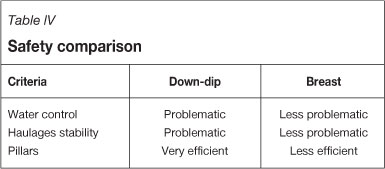
Minor adjustments for down-dip mining will ensure that water control and haulage stability is less problematic. Proper pumping systems should be used for down-dip mining, and haulages for down-dip mining should be developed at the same location as for breast mining.
Mining rate comparison
Development comparison
The rate at which development excavations advance is the same for both mining methods, although the amount and sequencing differs. Table V summarizes the on- and off-reef development, amount of predevelopment required, and the total development required. The on- and off-reef development are calculated here but will be rated under cost. In Table VI ratios are worked out in order to make relevant comparisons. The cubic metres mined as stoping during ledging is not considered here as this is not a development excavation. It does influence the total cubic metres that need to be mined before full stoping can start, but does not prolong the process as the stope and ASG are ledged simultaneously. The way in which the sequencing of development activities influences the mining rates is discussed later in the development and production section.
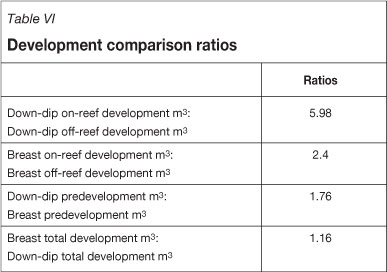
Table VI shows that the amount of on-reef development for down-dip mining is six times the amount of off-reef development. The amount of on-reef development for breast mining is 2.4 times the amount of off-reef development. The amount of predevelopment required for down-dip mining is 1.8 times the amount of predevelopment required for breast mining. In total, breast mining requires 1.2 times the amount of development needed for down-dip mining.
Production comparison
The square metres per crew per month and its ratio for the two mining methods are given in Table VII. The square metres per crew per month will be influenced by the advance per blast, panel length, blasting shifts per month, and blasting efficiency. Equation [1] was used to calculate the m2/crew in Table VII.
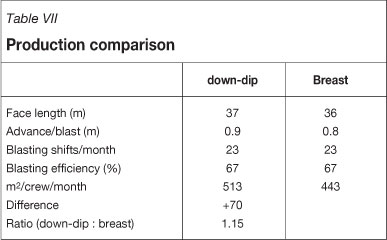
m2/crew/month = face length*advance/[1] blast*blasting shifts/month*blasting efficiency
The results from Table VII show that down-dip mining has a production capability 1.15 times greater than breast mining. It is important to note here that the production target set by the mine is 420 m2/crew/month. Both mining methods should be able to deliver on the target.
Production and development comparison
The combined effect of the amount of development required, production rate, and sequencing is considered in this section in order to determine the sustainability of the mining rate.
Gantt charts were drawn up for this purpose and are given in Figure 3 and Figure 4.


The rates of advance and lengths for production and development excavations, combined with optimum sequencing of the crews were used to draw up the Gantt charts.
For each mining method, the number of blasting shifts required to mine out each different excavation and the sequencing can be seen on the Gantt charts. The total number of blasting shifts is an indication of how long it will take to complete the development and production on a standard block of ground. Two development crews and three stoping crews are employed on a standard block of ground.
Table VIII summarizes the result from the Gantt charts, and also gives the number of shifts that will be required to mine out the second and third blocks. Ratios for the mining rates were also calculated in order to see if stoping for dip mining will catch up with development and hold up the production process. This will determine the sustainability of mining rate.
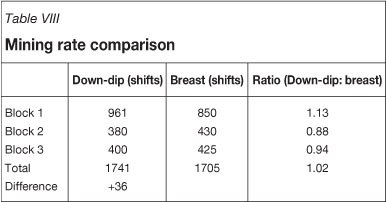
The number of blasting shifts for the second and third blocks are significantly less than that for the first, because they were predeveloped. The development crews moved over to the second and third blocks once their work was completed on the first block.
Table VIII indicates that down-dip mining takes 1.13 times as long as breast mining to mine the first block. This is because of all the predevelopment that has to be completed before production can start for down-dip mining. Breast mining takes 1.13 times longer than down-dip mining to mine out the second block. Down-dip mining is faster because part of the development has been completed by the development crews before stoping crews move in. The advantage of a higher production rate for down-dip mining can be seen here. Breast mining takes 1.06 times as long as down-dip mining for the third block. The advantage of a higher production rate for down-dip mining can still be seen here, but it starts decreasing as the stoping crews have to wait for predevelopment to be completed.
Stoping crews are held up by production crews once the third block is reached. This effect will roll over to the next block of ground until the advantage of the higher production rate for down-dip mining is lost.
When the stoping crews move on to the second block for down-dip mining, the first development crew will already be on the third block although the incline development crew will still be busy with the second block. For breast mining, both development crews will already be on the third block. This also proves that development will not be able to keep up with production for down-dip mining, although breast mining will not have this problem. Thus the mining rate for down-dip mining is not sustainable.
Cost comparison
In order to determine the total cost difference between the two mining methods per cubic metre mined, the costs for development and stoping have to be considered. Equipment and labour costs were considered, while material cost was assumed to be the same. This can be done because only the high cost influencers were considered. The difference in cost per square metre mined is calculated by using the size of a standard block of ground: 210 m by 180 m, or 37800 m2.
Development cost comparison
The difference in development cost was calculated by considering factors identified in the cost section of the layout comparison. The costs per metre of flat development, incline development, and orepass development, as well as boxfront costs are given in Table IX. The amount of flat development, incline development, and orepass development required for each mining method are also given in order to calculate the development cost difference per cubic metre mined. This includes the material, equipment and labour cost for development.
The cost per metre of incline development differs because down-dip mining has eleven crew members, whereas breast mining has eight crew members. With three more crew members, down-dip mining can blast two development excavations per shift. This means that by adding three members to the crew, twice the advance is achieved per shift. The overall cost of incline development for down-dip mining is thus lower than for breast mining.
Table IX shows that development for breast mining costs R38/m2 mined more than down-dip mining.
Production cost comparison
For the production cost calculation no up- to- date cost per square metre mined was available for down-dip mining as the mine has not used this method for 8 years. The cost per square metre mined will not be calculated, but rather the difference in cost per square metre mined for the two mining methods. Only factors that have a major influence on the cost for the two methods were considered, as given in the cost section under layout comparison. The cost calculation is broken down into equipment and labour.
Production equipment cost comparison
The production equipment cost comparison and difference in cost per square metre mined for the two mining methods are given in Table X.
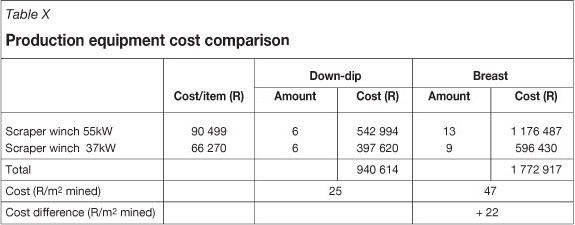
Table X shows that breast mining costs R22/m2 mined more than down-dip mining to equip.
Production labour cost comparison
The production labour costs were calculated using Equation [2] and are given in Table XI. Table XII gives the production labour cost comparison expressed as the difference in cost per square metre mined for the two mining methods.
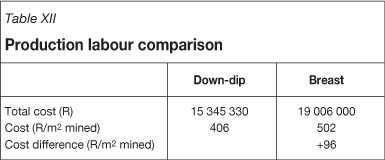
Labour cost = employees/crew*salary/month/[2] employee*months employed
Table XIII shows that breast mining costs R156/m2 mined more than down-dip mining.
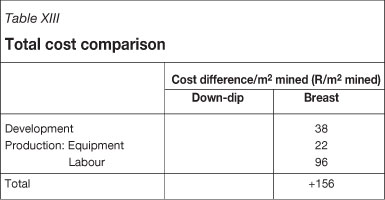
Comparison for other factors
Other factors have already been evaluated in the layout comparison section. The results are tabulated in Table XIV.
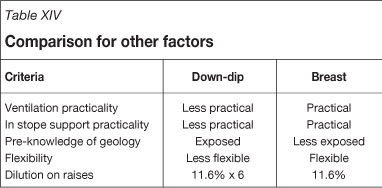
Evaluation and analysis of results
Here the results obtained are used to perform a trade-off in order to determine which method has the highest performance rating and is thus the most suitable. This procedure has been described in detail in the literature survey section, discussing methods for the selection of a mining method. Table XV gives the performance rating for the two mining methods.
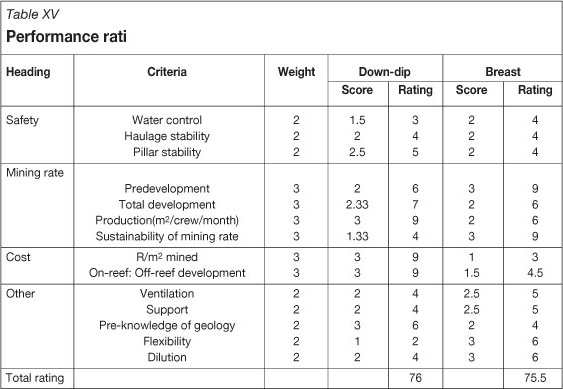
From Table XV it can be seen that down-dip mining and breast mining have the same safety performance rating. Down-dip mining has a poor mining rate performance rating of 26, while breast mining has a good mining rate performance rating of 30. Down-dip mining has a good cost performance rating of 18, while breast mining has a poor cost performance rating of 7.5. The performance rating for other factors is 20 for down-dip mining and 26 for breast mining. The overall performance rating, of the two mining methods are very similar, with down-dip mining achieving 76 and breast mining 75.5 out of an optimum of 102.
With down-dip mining having a performance rating only 0.5 higher than breast mining, it will not be worth changing over from breast mining to down-dip mining; a changeover will adversely influence the production output as problems will be experienced during this phase. Down-dip mining does, however, have the most potential for improvement in its performance rating. The major problem for down-dip mining is the mining rate performance, while for breast mining it is the cost performance. The mining rate performance rating for down-dip mining can be improved by increasing the labour employment of the incline development in order to increase the rate of development, as there are funds available due to the lower cost of down-dip mining. No method to reduce the cost of breast mining relative to down-dip mining could be identified.
Conclusions
In the safety performance rating, both mining methods achieved a rating 8 indicating that they are equally suitable in terms of safety
For mining rate performance, down-dip mining achieved a rating of 26 while breast mining achieved a rating of 30. Both mining methods are capable of achieving the production target set on the mine, but breast mining will be the more suitable method in terms of the overall mining rate and will yield a higher sustainable production output than down-dip mining
For the cost performance rating, down-dip mining achieved a rating of 18 while breast mining achieved a rating of 7.5. This indicates that the cost for down-dip mining is significantly lower than the cost for breast mining, making down-dip mining more economic
For the performance rating for other factors, down-dip achieved a rating of 20, while breast achieved a rating of 26. This indicates that breast mining will perform better on all other factors
For the overall performance, down-dip mining achieved a rating 0.5 higher than breast mining, which shows that the overall performances are similar
With such a small difference in performance rating for the two mining methods, it will not be worth changing over from breast mining to down-dip mining under current conditions
Down-dip mining has the most potential for improvement in its mining rate performance and funds are available to cover this cost, although further work is required to see how much improvement can be made.
Recommendations
It is recommended that Khomanani 2 continue practising breast mining on the Merensky Reef under current conditions
Attention should be given to non-method related factors that may influence the production output of breast mining, as it was shown that this method should be able to reach the production targets set on the mine
Further work needs to be done in order to determine how the performance rating of down-dip mining can be increased, which will allow down-dip mining to be reconsidered as an option > It should be taken into account that there will be a changeover period during which the production output will be adversely affected. Once a method is selected, it will be best to continue using this method.
Suggestions for further work
A study investigating the effect of increasing the incline development labour for down-dip mining is needed. This will show by how much the mining rate performance and overall performance rating can be increased and whether down-dip mining can be reconsidered as an option. A study identifying which non-method related factors are hampering the production output of breast mining will also be needed, as it was proven that breast mining should be able to achieve the production target set on the mine. The effects of a changeover need to be examined in case the mine decides to make the change.
References
1. NEUHOFF, H. Critical investigation of down-dip mining and breast mining at Frank shafts, thesis. University of Pretoria, 2008. p. 2. [ Links ]
2. MUSINGWINI, C., MINNIT, R.C.A., and WOODHALL, M. Technical operating flexibility in the analysis of mine layouts and schedules. International Platinum Conference 'Platinum Surges Ahead'. The Southern African Institute of Mining and Metallurgy, Johannesburg, 2006. p. 160. [ Links ]
3. HUSTRULID, W.A. and BULLOCK, R.L. (ed.). Underground Mining Methods. Society for Mining, Metallurgy and Exploration, (SME), Englewood, Colorado, 2001. pp. 16-17. [ Links ]
4. DELA VERGNE, J.N. Hard Rock Miners's Handbook. 1st edn. Mcintosh Redpath Engineering, North Bay, Ontario, 2000. pp. 43-44. [ Links ]
5. HARTMAN, L.H. (ed.). SME Mining Engineering Handbook. 2nd edn. AIME, Englewood, Colorado, 1992. p. 2049. [ Links ]
6. Stope Design and Layout. http://www.miningwiki.com [Accessed 2 November 2010] [ Links ].
7. MUSINGWINI, C. and MINNIT, R.C.A. Ranking the efficiency of selected platinum mining methods using the analytic hierarchy process (AHP). Third International Platinum Conference 'Platinum in Transformation', The South African Institute of Mining and Metallurgy, 2008. p. 319-326. [ Links ]
Paper received Jan. 2012
Revised paper received Jan. 2012
Paper written on project work carried out in partial fulfilment of B. Eng (Mining).














